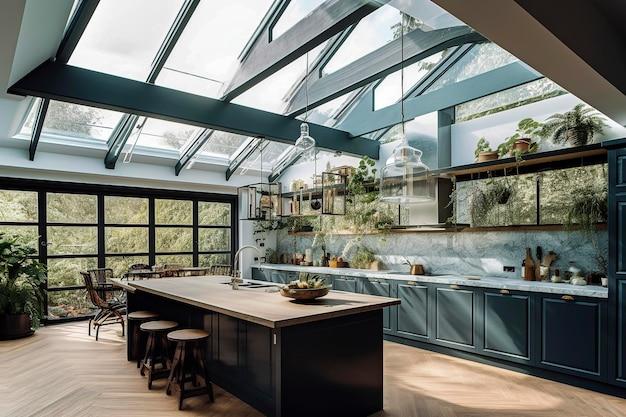So, you’re thinking about adding a sunroom to your house. It’s a fantastic idea – bringing in natural light, providing a space to relax and enjoy the outdoors, and even potentially increasing the value of your home. But before you dive into this exciting project, you might have a few questions on your mind. One of the most common inquiries is whether a sunroom counts as square footage. In this blog post, we’ll explore this topic in detail and answer all your burning questions about sunrooms and their impact on your home’s square footage.
Do Sunrooms Count as Square Footage
So you’re thinking about adding a sunroom to your home. It’s a fantastic idea! Sunrooms provide a beautiful space where you can enjoy the outdoors while staying protected from the elements. But you may be wondering, does a sunroom count as square footage? Let’s uncover the truth behind this question.
The Definition of Square Footage
Before we delve into the world of sunrooms, let’s start by understanding what square footage really means. On a basic level, square footage refers to the measurement of the area within the perimeter of a space. It’s a way to quantify how much floor space you have in a particular room, building, or property.
The Debate Around Sunrooms
Now, let’s explore whether sunrooms should be considered when calculating the square footage of a home. This topic has sparked many discussions among real estate professionals, property appraisers, and homeowners alike.
Sunrooms and Appraisal Guidelines
According to the Appraisal Institute, sunrooms must meet certain criteria in order to be included in the total square footage calculation of a home. For a sunroom to count, it must have all the necessary permits, be heated and cooled using the home’s primary system, and have the same level of finish as the rest of the house. In other words, if your sunroom meets these requirements, it may very well be included in the official square footage.
An Alternative Perspective
However, not all appraisers and real estate professionals agree on this matter. Some argue that sunrooms should be classified as enclosed porches or additional living spaces, rather than indoor square footage. In these cases, sunrooms may be mentioned separately in home listings, but they don’t add to the overall square footage tally.
The Impact on Home Value
Whether a sunroom counts as square footage or not, it can still have a significant impact on the value of your home. Sunrooms are highly desirable features for many homebuyers. They offer a unique space that brings the outdoors in, creating a peaceful retreat. So even if a sunroom doesn’t technically increase your home’s square footage, it may still enhance its overall appeal and market value.
In the end, the debate over whether sunrooms count as square footage boils down to various factors, including local regulations, appraisal guidelines, and personal perspectives. If you’re planning to add a sunroom, it’s essential to consult with professionals in your area who can provide guidance on how it will impact your home’s square footage and overall value. Regardless of the official square footage, a sunroom can bring immense joy and relaxation to your life, making it a worthwhile addition to your home.
Does a Sunroom Need a Permit
When you’re considering adding a beautiful sunroom to your home, you may wonder if you need a permit to bring your dream to life. The short answer is, it depends on where you live and the specifics of your project. Let’s dive into the details and shed some light on whether you’ll need to deal with permits or not.
Knowing the Rules
Before starting any home improvement project, it’s essential to research your local building regulations. Each city and county may have different requirements, so it’s crucial to understand the rules specific to your area. Taking the time to do your due diligence now can save you headaches and potential fines down the road.
Determining Factors
Several factors come into play when determining whether you’ll need a permit for your sunroom. Here are a few things to consider:
1. Size
In many areas, the requirement for a permit is based on the size of the structure. If your sunroom is considered an “addition” and exceeds a specific square footage, a permit will likely be necessary. It’s always best to check with your local building department to determine the specific threshold that triggers the need for a permit.
2. Electrical and Plumbing
If your sunroom project involves adding electrical wiring or plumbing, it’s highly likely you’ll need to obtain a permit. These types of installations typically require proper inspection to ensure they meet safety standards.
3. Location
The location of your sunroom can also affect whether or not a permit is required. If your sunroom is built on an existing patio or deck, the regulations may be different than if you’re adding a new structure. It’s important to understand the zoning rules and any restrictions related to setback distances from property lines.
Benefits of Obtaining a Permit
While dealing with permits may seem like a hassle, there are several benefits to going through the proper channels:
1. Safety
Permits ensure that your sunroom is built to meet safety standards. Building inspectors review the construction process to confirm that everything is up to code, giving you peace of mind.
2. Resale Value
When it comes time to sell your property, having permits for any extensions or improvements can positively impact your home’s resale value. Buyers appreciate knowing everything is legal and up to code.
Permits: The Sunlit Path to a Beautiful Sunroom
Don’t let the idea of permits dim your enthusiasm for a stunning sunroom addition to your home. By understanding the regulations specific to your location, you can navigate the permit process smoothly and ensure your project is a success. Remember, when you follow the rules, the sun shines a little brighter on your new sunroom retreat.
Does a Sunroom Count as a Bedroom
If you’ve ever pondered about converting your sunroom into a cozy bedroom, you may have wondered whether it would actually be considered a legitimate bedroom. Well, fret not, my curious friend, for I am here to shed some light on this conundrum.
The Basics: What Defines a Bedroom?
Before we dive into the sunny specifics, let’s clarify what actually constitutes a bedroom. Typically, a bedroom is defined as a space that contains certain essential elements: a door for privacy, windows for ventilation, a means of exit in case of emergency, and, of course, a closet to stash all your sartorial splendors.
Sunroom Shenanigans: Can It Make the Cut?
Now, let’s talk about the star of the show – the sunroom. While sunrooms are glorious havens where nature meets design, their status as official bedrooms is a bit questionable. Most building codes require a bedroom to have a closet, and alas, sunrooms rarely come equipped with this quintessential feature. As a result, many building authorities do not consider a sunroom as a legally permissible bedroom.
A Legal Workaround: The Sleeping Porch Phenomenon
However, fear not, for there can be a silver lining to this cloudy situation. Some locales have a delightful little exception called the “sleeping porch,” which goes against the standard closet requirement. A sleeping porch is essentially an open-air room that serves as a bedroom when the weather permits. These unique spaces often have no closets, but they make up for it by providing a proper bedroom experience with their windows, doors, and ventilation.
The Bottom Line: It’s All About Local Regulations
When it comes down to it, dear reader, the categorization of a sunroom as a bedroom ultimately depends on the rules and regulations set forth by your local authorities. While some areas may be more lenient and accept the sunroom as a bedroom, others may choose to stick to traditional standards. Therefore, it’s crucial to consult your municipality’s building codes before embarking on any sunroom-to-bedroom conversion adventures.
Wrap Up: Sunrise or Sunset?
In conclusion, while a sunroom may not typically be considered a bona fide bedroom due to the lack of a closet, there may be exceptions like the whimsical sleeping porch. Nevertheless, it’s important to remember that building codes vary from place to place, so always check the local requirements to avoid any potential surprises down the road. So, whether you’re daydreaming about a sunny sanctuary or moonlit slumber, make sure you do your due diligence before transforming your sunroom into a bedroom oasis. Happy dreaming!
Is Sunroom Considered Living Space
So, you’re considering adding a sunroom to your home and you’re wondering if it will count as living space. It’s a common question, and luckily, I’m here to shed some light on the subject. Let’s dive in and find out if your sunroom can officially claim the title of “living space”!
The Definition of Living Space
Before we can determine whether a sunroom qualifies as living space, it’s important to understand what living space actually means. Generally, living space refers to any area of a house or apartment that is suitable for human habitation. It typically includes rooms like bedrooms, living rooms, kitchens, and bathrooms.
The Use of Your Sunroom
To determine whether your sunroom qualifies as living space, you need to consider how you plan to use it. If you’re using the space as a place to relax, entertain guests, or even as an additional dining area, then it can potentially be considered as living space. However, if your sunroom serves primarily as a storage area or a place to house your indoor plants, it may not meet the requirements.
Building Codes and Regulations
One important factor to consider is the local building codes and regulations in your area. Different jurisdictions may have specific requirements for what can be classified as living space. It’s crucial to consult with your local building department or a professional contractor to ensure that your sunroom meets all the necessary criteria.
The Key Factors
There are a few key factors that can help determine whether your sunroom qualifies as living space. Firstly, it should be a permanent addition to your home, properly insulated, and have a heating and cooling system in place. Secondly, it should be accessible through the main living area of your home, with a door providing direct access. Lastly, the sunroom should have flooring that is consistent with the rest of the house, such as wood or tile, rather than outdoor materials like concrete or gravel.
The Appraisal Factor
Another aspect to consider is the impact on your home’s appraisal value. If your sunroom meets all the requirements to be classified as living space, it can potentially increase the overall square footage of your home and consequently increase its value. This can be a significant advantage if you plan to sell your home in the future.
So, the answer to the question of whether a sunroom is considered living space depends on various factors, including the use of the space, local building codes, and adherence to certain criteria. It’s crucial to consult with professionals and local authorities to ensure compliance and make an informed decision. Ultimately, a sunroom can be a wonderful addition to your home, providing a relaxing space to enjoy the sun’s rays while potentially increasing the value of your property.
Does Adding a Sunroom Increase Taxes
So, you’ve decided to add a sunroom to your home. It’s a great way to enjoy the beauty of the outdoors while staying cozy and protected from the elements. But before you dive headfirst into this new venture, you might be wondering if adding a sunroom will have any impact on your taxes. Well, worry not, my friend, because I’m here to shed some light on this matter.
How Sunrooms Affect the Value of Your Home
When it comes to taxes, the value of your home is an important factor. The more your home is worth, the more you may have to pay in property taxes. So, the logical question is, does adding a sunroom increase the value of your home? The answer is… drumroll, please… it depends.
Adding a sunroom can potentially increase the value of your home, especially if it’s well-built and aesthetically pleasing. It provides additional living space, which is always a desirable feature for potential buyers. However, the extent to which it increases your home value may vary depending on several factors, such as the size of the sunroom, the quality of materials used, and the overall design.
The Effect on Property Taxes
Now, onto the burning question: will adding a sunroom cause your property taxes to skyrocket? Well, I have good news for you. In most cases, adding a sunroom won’t have a significant impact on your property taxes. That’s because not all jurisdictions consider sunrooms as livable square footage.
Tax assessors usually follow guidelines provided by the International Association of Assessing Officers (IAAO) when determining the square footage of a property. According to these guidelines, for a structure to be considered livable space and be included in the square footage calculation, it must have a permanent heating source, be accessible from the main living area, and be suitable for year-round use.
Exceptions and Variations
Of course, as with everything in life, there are exceptions and variations. Some jurisdictions may consider sunrooms as livable space if they meet certain criteria, such as having a separate heating or cooling system, being structurally insulated, or even being fully enclosed. In these cases, the square footage of the sunroom may contribute to the overall value of your home and potentially impact your property taxes.
To find out how sunrooms are treated in your specific jurisdiction, it’s best to consult with your local tax assessor’s office or a real estate professional who is knowledgeable about local regulations.
The Verdict
So, there you have it. Adding a sunroom is unlikely to cause a drastic increase in your property taxes. In most cases, the value it adds to your home isn’t considered when calculating property taxes. However, it’s always a good idea to do your due diligence and consult with local authorities to understand how sunrooms are treated in your area. And remember, the primary goal of adding a sunroom is to enhance your living space and enjoy the beauty of nature – taxes are just an added consideration along the way!
Does a Sunroom Add Square Footage to a House
Understanding the Sunroom Conundrum
So, you’re contemplating the idea of adding a sunroom to your house. You envision a bright, warm space where you can bask in the sunlight while sipping your morning coffee or curl up with a good book. But before you dive headfirst into this home improvement project, there’s an important question that needs answering: Does a sunroom actually add square footage to your house?
The Surprising Truth
Well, here’s a bummer: sunrooms generally don’t count as official square footage when it comes to appraisals, taxes, or official documentation. They often fall under a gray area known as “unheated living space” or “three-season rooms.”
Appraisers and Assessor’s Office – United Stand
Appraisers and assessors typically follow a set of guidelines when determining the square footage of a house. They usually draw the line at considering only spaces that are heated, insulated, and livable year-round. Since sunrooms tend to lack proper insulation and have limited climate control, they are usually not classified as official square footage.
A Place for Relaxation and Recreation
Now, before you start feeling downtrodden, remember that just because a sunroom doesn’t add square footage doesn’t mean it lacks value. Sunrooms can provide an oasis-like escape from the rest of your house—an ideal spot to relax, enjoy nature, or entertain guests. Whether you use it as a meditation space, a home office, or a place to indulge your green thumb, a sunroom offers countless opportunities for enjoyment.
Property Value and Buyer Appeal
While a sunroom might not add numerical square footage, it can still increase the overall value of your property. Potential buyers often see sunrooms as an attractive feature, despite their square footage status. These light-filled spaces can boost the curb appeal of your home and create a unique selling point.
Building Regulations and Permits
When planning to add a sunroom, it’s crucial to check with your local building department to understand any regulations or permits required in your area. Some jurisdictions have specific rules regarding sunrooms, and failure to comply with these regulations can result in fines or other penalties. It’s always better to be safe than sorry!
So, while a sunroom may not officially add square footage to your house, it can certainly enhance your living experience and increase the value of your property. Don’t let the technicalities dampen your enthusiasm—seize the opportunity to create a space that brings you joy and makes your home that much more special. Embrace the sunshine!
Does an Enclosed Patio Count as Square Footage
An enclosed patio can be a fantastic addition to any home, providing extra space for relaxation and entertainment. However, when it comes to determining square footage, things can get a little tricky. Let’s take a closer look at whether an enclosed patio counts as square footage.
Understanding Square Footage
Before we delve into the specifics of enclosed patios, let’s first clarify what square footage actually means. Square footage refers to the measurement of a space’s area in square feet. It helps us determine the size of a room or a property and plays a crucial role in various aspects of real estate, such as property valuation and building codes.
The Gray Area
When it comes to enclosed patios, things aren’t always black and white. In some cases, an enclosed patio may be considered as part of the square footage, while in others, it may not. It ultimately depends on a few factors, such as how the area is built and how it is treated by appraisers and real estate agents.
Building Codes and Permits
In many jurisdictions, building codes dictate whether an enclosed patio can be counted as square footage. To count, the conversion from an open patio to an enclosed one typically requires proper permits and compliance with specific regulations. If the necessary permits aren’t obtained or the construction doesn’t meet the required standards, the enclosed patio may not be included in the square footage calculations.
Permanence and Functionality
Another factor that determines the inclusion of an enclosed patio in square footage is its permanence and functionality. If the enclosed patio is an integral part of the main structure, with heating and cooling systems connected, and can be used year-round as livable space, it’s more likely to be considered as square footage. On the other hand, if it’s more of a temporary or seasonal structure, it may not be counted.
Appraisal and Listing
When it comes to home appraisals or listing a property, it’s important to be transparent about the inclusion of an enclosed patio in square footage. Appraisers might consider various factors, such as local market trends and buyer preferences, to determine its value and inclusion in the overall square footage. Similarly, when listing a property, it’s best to mention whether the enclosed patio is included in the square footage or not, to avoid any confusion for potential buyers.
In the case of an enclosed patio, whether it counts as square footage or not depends on the specific circumstances, local regulations, and how it’s perceived by appraisers and buyers. While it can add value and versatility to a home, it’s essential to consider these factors and communicate clearly to ensure everyone involved has a complete understanding of the property’s square footage.
So, if you’re planning to enclose your patio and want it to count as additional square footage, make sure to follow the required procedures, obtain proper permits, and consult with professionals who can guide you through the process.
Do Sunrooms Count as Square Footage in California
In California, many homeowners are fortunate to enjoy the year-round sunshine and pleasant weather. As a result, sunrooms have become a popular addition to houses, providing a bright and airy space to relax and enjoy the outdoors while still being protected from the elements. But when it comes to calculating the square footage of a home, do sunrooms actually count? Let’s find out.
Sunrooms and the Square Footage Calculation
When it comes to determining the total square footage of a home, it’s essential to understand how sunrooms are classified. In California, the general rule is that a sunroom can only be counted towards the total square footage if it meets specific requirements.
Meeting the Requirements
To be considered as square footage, a sunroom in California must meet certain criteria. Firstly, it must have a heating and cooling system in place that is consistent with the rest of the home. This ensures that the sunroom is a habitable and livable space throughout the year. Additionally, the structure should be built to the same standards as the rest of the house and have a permanent, solid roof.
Permitted Versus Non-Permitted Sunrooms
It’s important to note that there are differences between permitted and non-permitted sunrooms. A permitted sunroom is one that has been built according to local building codes and has obtained the necessary permits. These structures are more likely to count as square footage when calculating the value of a home.
On the other hand, a non-permitted sunroom is one that has been added without the proper permits or does not meet applicable building codes. In most cases, non-permitted sunrooms will not be included in the square footage calculation.
The Impact on Property Value:
When a sunroom is counted as livable square footage, it can increase the overall value of a property. Square footage is an essential factor in determining the price of a home, and a well-designed and properly permitted sunroom can certainly add value. It provides additional living space that can be used for various purposes, such as a family room, lounge area, or even a home office.
However, it’s important to note that the value added by a sunroom may vary depending on market conditions, the quality of construction, and the overall desirability of the feature within a particular neighborhood.
Conclusion:
In California, sunrooms can count as square footage under specific conditions. If the sunroom meets the requirements set by the state, including a consistent heating and cooling system, compliance with building codes, and a permanent roof, it can be included in the square footage calculation of a home. This addition not only increases the total value of the property but also provides a versatile space that can enhance the homeowners’ enjoyment of their home. So, if you’re considering adding a sunroom, make sure to follow the proper guidelines to ensure it can be included in the square footage of your Californian home.



